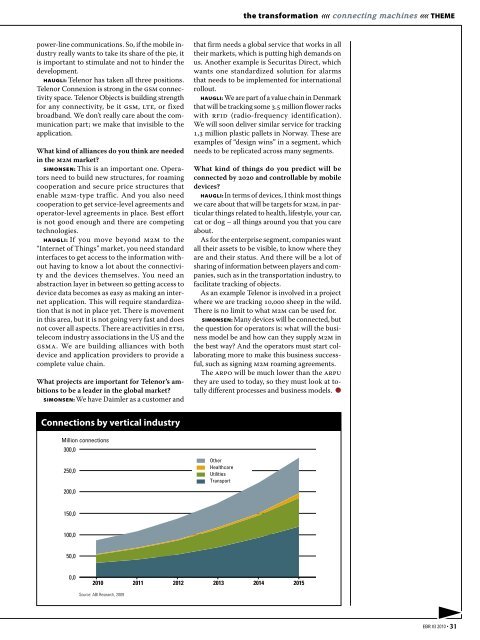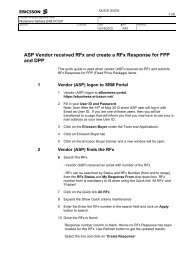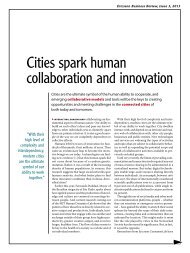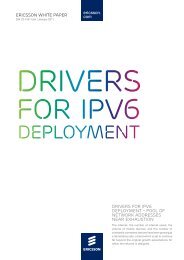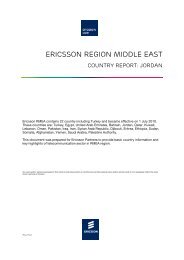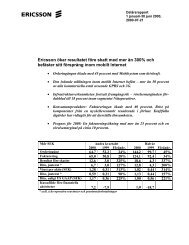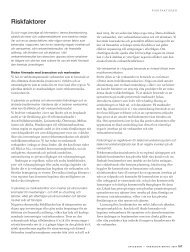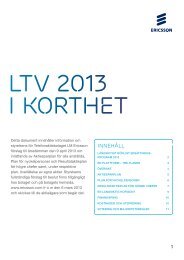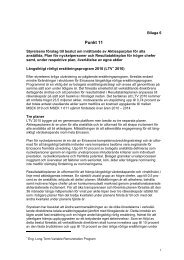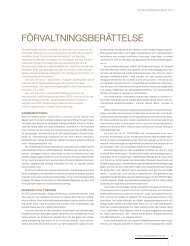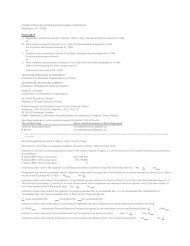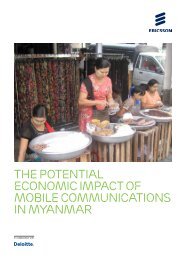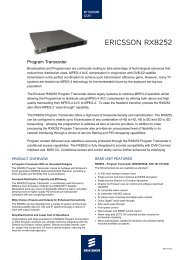Telenor's - Ericsson
Telenor's - Ericsson
Telenor's - Ericsson
- TAGS
- ericsson
- www.ericsson.com
You also want an ePaper? Increase the reach of your titles
YUMPU automatically turns print PDFs into web optimized ePapers that Google loves.
power-line communications. So, if the mobile industry<br />
really wants to take its share of the pie, it<br />
is important to stimulate and not to hinder the<br />
development.<br />
HAUGLI: Telenor has taken all three positions.<br />
Telenor Connexion is strong in the gsm connectivity<br />
space. Telenor Objects is building strength<br />
for any connectivity, be it gsm, lte, or fixed<br />
broadband. We don’t really care about the communication<br />
part; we make that invisible to the<br />
application.<br />
What kind of alliances do you think are needed<br />
in the m2m market?<br />
SIMONSEN: This is an important one. Operators<br />
need to build new structures, for roaming<br />
cooperation and secure price structures that<br />
enable m2m-type traffic. And you also need<br />
cooperation to get service-level agreements and<br />
operator-level agreements in place. Best effort<br />
is not good enough and there are competing<br />
technologies.<br />
HAUGLI: If you move beyond m2m to the<br />
“Internet of Things” market, you need standard<br />
interfaces to get access to the information without<br />
having to know a lot about the connectivity<br />
and the devices themselves. You need an<br />
abstraction layer in between so getting access to<br />
device data becomes as easy as making an internet<br />
application. This will require standardization<br />
that is not in place yet. There is movement<br />
in this area, but it is not going very fast and does<br />
not cover all aspects. There are activities in etsi,<br />
telecom industry associations in the US and the<br />
gsma. We are building alliances with both<br />
device and application providers to provide a<br />
complete value chain.<br />
What projects are important for Telenor’s ambitions<br />
to be a leader in the global market?<br />
SIMONSEN: We have Daimler as a customer and<br />
Connections by vertical industry<br />
Global M2M connections by vertical industry, 2010–2015<br />
Million connections<br />
300,0<br />
250,0<br />
200,0<br />
150,0<br />
100,0<br />
50,0<br />
0,0<br />
the transformation «« connecting machines «« THEME<br />
that firm needs a global service that works in all<br />
their markets, which is putting high demands on<br />
us. Another example is Securitas Direct, which<br />
wants one standardized solution for alarms<br />
that needs to be implemented for international<br />
rollout.<br />
HAUGLI: We are part of a value chain in Denmark<br />
that will be tracking some 3.5 million flower racks<br />
with rfid (radio-frequency identification).<br />
We will soon deliver similar service for tracking<br />
1,3 million plastic pallets in Norway. These are<br />
examples of “design wins” in a segment, which<br />
needs to be replicated across many segments.<br />
What kind of things do you predict will be<br />
connected by 2020 and controllable by mobile<br />
devices?<br />
HAUGLI: In terms of devices, I think most things<br />
we care about that will be targets for m2m, in particular<br />
things related to health, lifestyle, your car,<br />
cat or dog – all things around you that you care<br />
about.<br />
As for the enterprise segment, companies want<br />
all their assets to be visible, to know where they<br />
are and their status. And there will be a lot of<br />
sharing of information between players and companies,<br />
such as in the transportation industry, to<br />
facilitate tracking of objects.<br />
As an example Telenor is involved in a project<br />
where we are tracking 10,000 sheep in the wild.<br />
There is no limit to what m2m can be used for.<br />
SIMONSEN: Many devices will be connected, but<br />
the question for operators is: what will the business<br />
model be and how can they supply m2m in<br />
the best way? And the operators must start collaborating<br />
more to make this business successful,<br />
such as signing m2m roaming agreements.<br />
The arpo will be much lower than the arpu<br />
they are used to today, so they must look at totally<br />
different processes and business models. ●<br />
2010 2011 2012 2013 2014 2015<br />
Source: ABI Research, 2009<br />
Other<br />
Healthcare<br />
Utilities<br />
Transport<br />
▶<br />
EBR #3 2010 31


